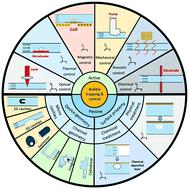Our official English website, www.x-mol.net, welcomes your
feedback! (Note: you will need to create a separate account there.)
Trapping and control of bubbles in various microfluidic applications
Lab on a Chip ( IF 6.1 ) Pub Date : 2020-11-13 , DOI: 10.1039/d0lc00906g Yuan Gao 1, 2, 3, 4 , Mengren Wu 1, 2, 3, 4 , Yang Lin 4, 5, 6, 7 , Jie Xu 1, 2, 3, 4
Lab on a Chip ( IF 6.1 ) Pub Date : 2020-11-13 , DOI: 10.1039/d0lc00906g Yuan Gao 1, 2, 3, 4 , Mengren Wu 1, 2, 3, 4 , Yang Lin 4, 5, 6, 7 , Jie Xu 1, 2, 3, 4
Affiliation

|
As a simple, clean and effective tool, micro bubbles have enabled advances in various lab on a chip (LOC) applications recently. In bubble-based microfluidic applications, techniques for capturing and controlling the bubbles play an important role. Here we review active and passive techniques for bubble trapping and control in microfluidic applications. The active techniques are categorized based on various types of external forces from optical, electric, acoustic, mechanical and thermal fields. The passive approaches depend on surface tension, focusing on optimization of microgeometry and modification of surface properties. We discuss control techniques of size, location and stability of microbubbles and show how these bubbles are employed in various applications. To finalize, by highlighting the advantages of these approaches along with the current challenges, we discuss the future prospects of bubble trapping and control in microfluidic applications.
中文翻译:

各种微流体应用中气泡的捕获和控制
作为一种简单,干净且有效的工具,微气泡最近在各种芯片实验室(LOC)应用中取得了进步。在基于气泡的微流体应用中,用于捕获和控制气泡的技术起着重要的作用。在这里,我们回顾了微流体应用中气泡捕获和控制的主动和被动技术。根据来自光学,电场,声学,机械和热场的各种外力对主动技术进行分类。被动方法取决于表面张力,重点是优化微几何形状和修改表面性能。我们讨论了微气泡的大小,位置和稳定性的控制技术,并展示了这些气泡如何在各种应用中使用。最后,
更新日期:2020-11-25
中文翻译:

各种微流体应用中气泡的捕获和控制
作为一种简单,干净且有效的工具,微气泡最近在各种芯片实验室(LOC)应用中取得了进步。在基于气泡的微流体应用中,用于捕获和控制气泡的技术起着重要的作用。在这里,我们回顾了微流体应用中气泡捕获和控制的主动和被动技术。根据来自光学,电场,声学,机械和热场的各种外力对主动技术进行分类。被动方法取决于表面张力,重点是优化微几何形状和修改表面性能。我们讨论了微气泡的大小,位置和稳定性的控制技术,并展示了这些气泡如何在各种应用中使用。最后,











































 京公网安备 11010802027423号
京公网安备 11010802027423号